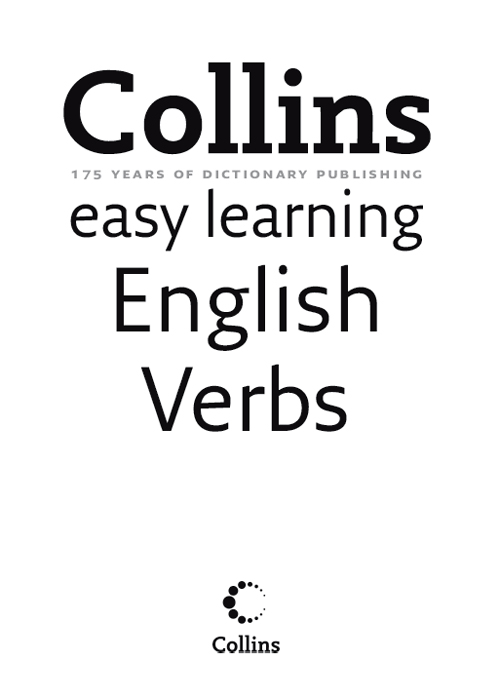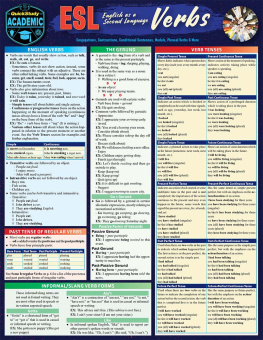

HarperCollins Publishers
Westerhill Road
Bishopbriggs
Glasgow
G64 2QT
First edition 2010
Reprint 10 9 8 7 6 5 4 3 2 1 0
HarperCollins Publishers 2010
EPUB Edition November 2011 ISBN 978-0-00-746194-3
Collins is a registered trademark of
HarperCollins Publishers Limited
www.collinslanguage.com
A catalogue record for this book is available from the British Library
Printed in Great Britain by Clays Ltd, St Ives plc
All rights reserved. No part of this book may be reproduced, stored in a retrieval system, or transmitted in any form or by any means, electronic, mechanical, photocopying, recording or otherwise, without the prior permission in writing of the Publisher. This book is sold subject to the conditions that it shall not, by way of trade or otherwise, be lent, re-sold, hired out or otherwise circulated without the publishers prior consent in any form of binding or cover other than that in which it is published and without a similar condition including this condition being imposed on the subsequent purchaser.
Entered words that we have reason to believe constitute trademarks have been designated as such. However, neither the presence nor absence of such designation should be regarded as affecting the legal status of any trademark.
Editorial staff
Senior editors:
Penny Hands
Kate Woodford
Project management:
Anne Robertson
Lisa Sutherland
Contributors:
Sandra Anderson
Jennifer Baird
Katharine Coates
For the publisher:
Lucy Cooper
Kerry Ferguson
Elaine Higgleton
Computing support:
Thomas Callan
introduction
Collins Easy Learning English Verbs is designed for anyone who wants to improve their knowledge of English verbs and the way they work. Whether you are preparing for exams, need a quick look-up guide to English verbs, or you simply want to browse, Collins Easy Learning English Verbs offers you the information you require in a clear and accessible format.
A verb is a word which tells us about an action, an activity, a process, a state of being, or a state of mind. All grammatically complete sentences in English contain at least one verb. The form of a verb helps us to express some important ideas: the time the action is taking place, who carries it out, how likely it is that it will happen, how many people perform the action, and so on.
The first section of the book, called What is a verb?, tells you more about tenses, the different grammatical forms of the verb, and how verbs work in a sentence.
The second section of the book contains dictionary entries of the most important types of verb. Most verbs in English are main verbs; these express actions and states. A special type of verb, called an auxiliary verb, is used in combination with a main verb to express ideas such as time, certainty, doubt, and completion. Some examples of auxiliary verbs are be, do, have, can, could, and will. Auxiliary verbs are explained in detail in the key entries in the dictionary section.
Phrasal verbs are also an important feature of English. English speakers use phrasal verbs in all contexts not just in informal situations. The most common phrasal verbs are listed at the end of the entry for the verb they relate to. For example, the phrasal verbs hang on and hang up are listed under the entry for hang.
Some of the most useful English verbs are irregular. Irregular verbs are verbs which do not form the past simple tense and the past participle in the regular way. The most important irregular verbs are marked with a star in the dictionary section. There is also a list of the most common irregular verbs and their inflections on .
All explanations throughout the book are fully illustrated with examples of natural English taken from the Collins 2.5-billion-word corpus.
We hope you enjoy finding out more about this important area of the English language. For more information about Collins dictionaries, visit us at
www.collinslanguage.com.
guide to entries

pronunciation guide
We have used the International Phonetic Alphabet (IPA) to show how the words are pronounced. The symbols used in the International Phonetic Alphabet are shown in the table below.
IPA symbols
Vowel sounds
a  | calm, ah |
| act, mass |
| aI | dive, cry |
| aI | fire, tyre |
| a | out, down |
| a | flour, sour |
| e | met, lend, pen |
| eI | say, weight |
| e | fair, care |
| I | fit, win |
| i: | seem, me |
| I | near, beard |
| lot, spot |
| note, coat |
 | claw, more |
| I | boy, joint |
| could, stood |
u  | you, use |
| lure, pure |
3  | turn, third |
| fund, must |
| the first vowel in about |
Consonant sounds
| b | bed, rub |
| d | done, red |
| f | fit, if |
| g | good, dog |
| h | hat, horse |
| j | yellow, you |
| k | king, pick |
| l | lip, bill |
| m | mat, ram |
| n | not, tin |
| p | pay, lip |
| r | run, read |
| s | soon, bus |
| t | talk, bet |
| v | van, love |
| w | win, wool |
| x | loch |
| z | zoo, buzz |
| ship, wish |
| 3 | measure, leisure |
| sing, working |
| t | cheap, witch |
| thin, myth |
| then, bathe |
| joy, bridge |
Notes
Primary and secondary stress are shown by marks above and below the line, in front of the stressed syllable. For example, in the word abbreviation, /,bri v I e I sn/, the second syllable has secondary stress and the fourth syllable has primary stress.
v I e I sn/, the second syllable has secondary stress and the fourth syllable has primary stress.
What is a verb?
the verb phrase
What is a verb?
A verb tells us about an action, an activity, a process, a state of being, or a state of mind. Ordinary verbs are called main verbs.
This basket holds quite a lot.
Next page




















